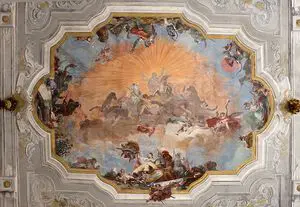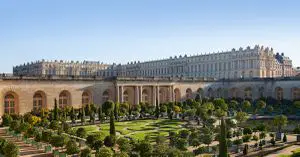Grand Ornate Style of Art and Architecture Popular During the Age of Louis Xiv

Figure 1. An case of quadratura from Ca' Rezzonico in Venice.
The Baroque mode is seen as a generally lively or even ostentatious creative, architectural, and musical style from the late 17th to the late 18th century. This vivid style is prominent in regions in what are today Italy, France, Spain, Portugal, Federal republic of germany, and Republic of austria, where it represents a movement that became particularly pop amidst Cosmic regions or countries in the wake of the Protestant Reformation. This vividness contrasts greatly from the plain and often wearisome styles of Protestant Europe, although eventually Baroque styles fifty-fifty influenced these regions.
Context of Development
The context of Bizarre development has to be seen in light of the not bad religious conflicts of the sixteen-17th centuries, such as the initial conflict between Luther and the Catholic Church and somewhen the Xxx Years War that tore much of Europe apart. During the Council of Trent, in 1545–63, the Cosmic Church was looking for a new style that would contrast itself from Protestantism and likewise give it a style that people could cover. Initially, this was in the form of austere buildings that had few fans. Soon, however, the movement that became the Bizarre began with new developments in architecture in Italy, which in the early on 17th century embraced color, vivid display, and pageantry. This is manifested in the cupolas that constituted the large church building domes and quadratura ceiling paintings.
Church interiors became highly decorated and more decorative elements were added to the chantry and columns of the swell hall within the church. Emphasis was to put the parishioners close to the chantry to make them experience the grandeur of the church and ceremony. Twisting columns had begun to develop that allowed also light reflection that gives a sense of motion (Effigy i). These styles presently found themselves in palaces and secular architecture too.[1]
In the early on 17th century, Bizarre now began to spread to statuary fine art, or at least influences in thought began to bear upon bronze limerick. This included piece of work by Gian Lorenzo Bernini, who became perhaps the about influential artist to bear upon statuary expression of the Baroque manner. Statues began to become more lively and expressive rather than stern. Bernini would subsequently influence Giuseppe Pannin, who would go on to make the largest Baroque-style fountain in Rome, the Trevi Fountain. Music in the late 1580s already began to plough away from the Renaissance music style every bit composers such as Jacopo Peri began to develop not merely Baroque style but as well what would become opera. Dafne was composed by him in 1597 and is often considered as the beginning truthful opera. The Medici courtroom had patronized him and he was also influenced by Jacopo Corsi. New musical innovations or heavy utilize of older ideas began to exist associated with the Baroque style, including more than harmony and use of tonality that would sometimes improvise on the chords.
The mid-17th-18th century began to get chosen the High Baroque, where experimentation with new ostentatious styles in architecture formed as well as in art. Paintings now took on more bright appearances, where the depiction of motility was critical to the setting. Contrasts and warm colors were used in paintings to give them more than life, including using more white to add brightness. The integration of vivid art scenes with Baroque compages became in great vogue, where artists such equally Pietro da Cortona began to integrate lively figures inside architecture in churches.[two]
Spread of the Bizarre

Figure ii. A view of the Palace of Versailles from one of the main gardens.
Although ane can say already some churches in Italian republic, particularly Rome, in the 1580s began to display a new Baroque manner, most of the Bizarre in the tardily 16th century was bars to Italy. It only actually began to spread in the early on 1600s, when Spain began to create its own Baroque churches, such every bit the San Isidro Chapel in Madrid. The Baroque way shortly began to change and suit to local styles as it spread further still. The 17th century, with its heightened tensions between increasingly separated factions of Europe due to religious conflict, increasingly this menstruation saw art and compages as expressions of that separation, with the Baroque existence a key example. In France, the Classical manner was a form of Bizarre popularised past Louis 14 and XV, where architecture was far more geometric and maintaining simpler forms where symmetry was the focus. The Palace of Versailles built in the 1680s exemplifies the Baroque style used in French architecture. On the one hand, the palace was extremely large and ornate, but the external elements were generally less ornate and more than conformed to more geometric proportions (Figure 2).[3]
In regions such as Frg and Austria, particularly in Bavaria and in southern Germany where many Catholics lived, Bizarre became very fashionable from the mid-late 17th century. In fact, information technology is in Frg where we also meet how the Baroque style influenced Protestant regions, forming what was called Protestant Baroque. Palaces such as in Salzburg, Potsdam, Dresden (Zwinger Palace), and Berlin were just some examples of local rulers utilising the Baroque manner for their own tastes. German Bizarre, especially in the Protestant areas, was not equally ostentatious as more Catholic areas. In Protestant areas, more use of symmetry and geometric patterns in architecture were used, what would become like to the Classical style in France. One of the most vivid examples of Baroque influences was on Salzburg, a largely Catholic urban center, where about the entire Medieval urban center was demolished to make mode for a Baroque city with new urban layouts, fountains, squares, churches, and official buildings. [iv]
Later the Bizarre Period
In France, the bizarre style gave way to the Rococo, which was a fashion that contained asymmetry, curvy depictions with heavier apply of white and pastel colors in paintings. This was during the mid to tardily 18th century; still, most scholars consider this mode as an off-shoot and influenced by the Baroque manner. By the belatedly 18th century, at that place was renewed involvement in more traditional Classical themes in art and architecture. The Paladin style, which was already popular in Great britain where the Baroque way never became popular for British tastes, emphasized proportional, free-continuing buildings that were geometrically compatible and less ornate.
This way became more popular in Europe in the 19th century, as more than ostentatious views on compages and art became less pop. In Britain, there was an eventual renewed interest in the past in the mid 19th century, leading to a revived Gothic mode or interest that characterized well known Victorian buildings and architectural styles.[5]
Summary
The baroque mode started as a reaction or even part of the wider counter-reformation movement against Protestant Europe. The use of baroque was a way for Catholic parts of Europe to easily distinguish themselves. It soon developed a number of sub-styles and local variations of baroque developed in the countries where information technology was adopted. From the 17th and most of the 18th centuries, baroque dominated the arts, including architecture, sculpture, including music with famous composers such as Bach being a product of this era.
References
- ↑ For more on the initial and what would become the key elements of the Baroque style of architecture and fine art, run across: Millon, Henry A., Musée des beaux-arts de Montréal, National Gallery of Art, Musée des Beaux-Arts, and Fiat SpA, eds. 1999. The Triumph of the Baroque: Architecture in Europe 1600-1750. London: Thames & Hudson.
- ↑ For more on art, sculptures, and music in the Bizarre menstruation, meet: Sitwell, Sacheverell. 2006. Southern Baroque Fine art: Painting, Architecture and Music in Italy and Spain of the 17th & 18th Centuries. Home Farm Books.
- ↑ For more than on the spread and influences of Bizarre manner on different regions, see: Minor, V.H. 2004. Baroque & Rococo: Art & Civilization. Princeton, N.J.: Recording for the Bullheaded & Dyslexic.
- ↑ For more on the Baroque and its influences, including in Protestant regions, see: Maravall, José Antonio. 1986. Civilization of the Baroque: Analysis of a Historical Construction. Theory and History of Literature, five. 25. Minneapolis: University of Minnesota Printing.
- ↑ For more on the mail service-Bizarre menstruation and styles, see: Kaufmann, Emil. 2013. Compages in the Age of Reason: Baroque and Postbaroque in England, Italy, and France. Cambridge: Harvard Academy Printing.
Maltaweel and Admin
teichelmannsiled1978.blogspot.com
Source: https://dailyhistory.org/Why_did_the_Baroque_Style_develop